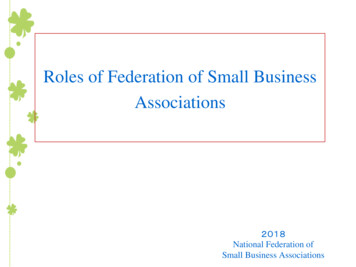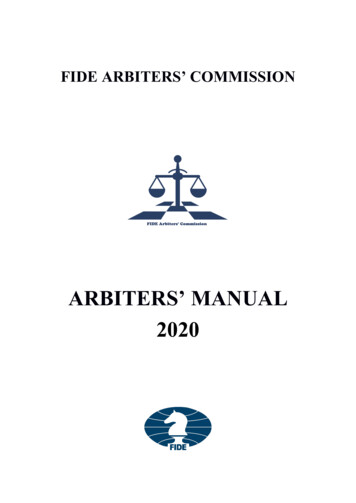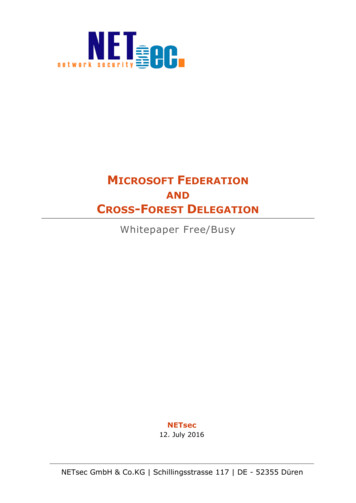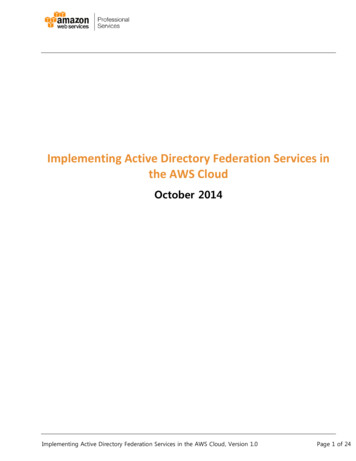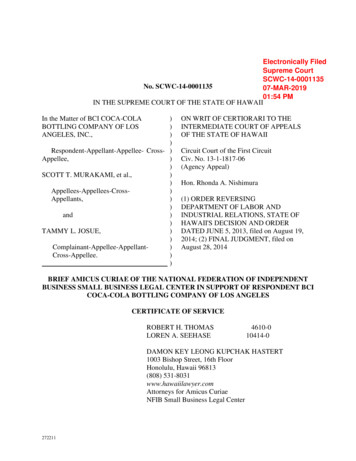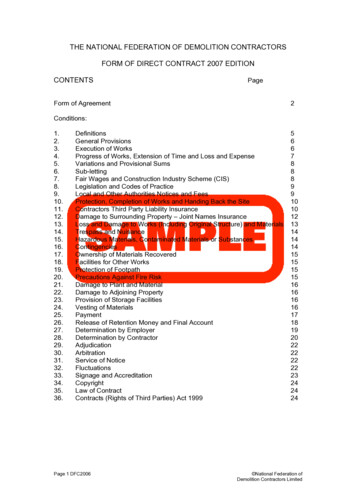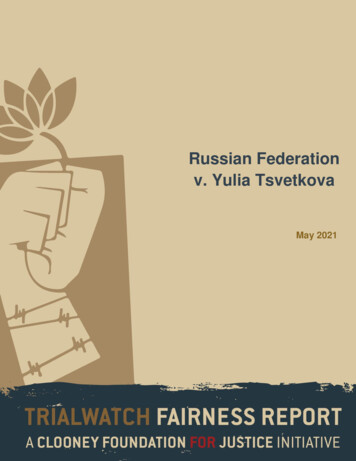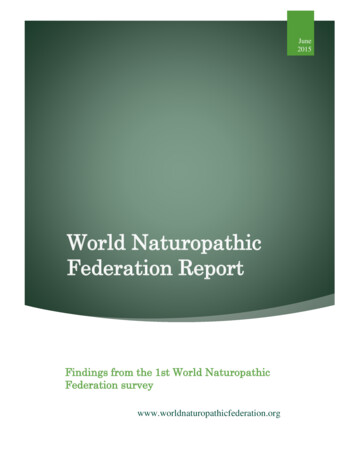
Transcription
June2015World NaturopathicFederation ReportFindings from the 1st World NaturopathicFederation surveywww.worldnaturopathicfederation.org
World Naturopathic Federation ReportJune 2015AcknowledgementsThe World Naturopathic Federation (WNF) greatly appreciates the participation ofnaturopathic organizations around the world (outlined in the document) in providing thedetails required for this World Naturopathic Federation Report.This survey initiative was led by Dr. Iva Lloyd, ND. Other naturopathic doctorsinstrumental in this report include Jonathan Wardle, Tabatha Parker, Tina Hausser andPhillip Cottingham, as well as other members of the WNF Interim Board.We appreciate those individuals that assisted by reviewing this document and providingcomments and advice on the content.WNF Interim Board Members include naturopaths / naturopathic doctors:Iva Lloyd – President (Canada)Tabatha Parker – Vice President (United States)Jonathan Wardle - Treasurer (Australia)Tina Hausser – Secretary (Spain)Phillip Cottingham – New ZealandAnne-Marie Narboni – FranceYannick Pots – BelgiumDhananjay Arankalle – India World Naturopathic Federation June 2015All rights reserved. Publications of the World Naturopathic Federation can be obtainedfrom their website at www.worldnaturopathicfederation.org. Requests for permission toreproduce or translate WNF publications – whether for sale or for noncommercialdistribution – should be addressed to info@worldnaturopathicfederation.orgAll reasonable precautions have been taken by the World Naturopathic Federation toverify the information in this report. However, the published material is being distributedwithout warranty of any kind, either expressed or implied. The responsibility for theinterpretation and use of the material lies with the reader. In no event shall the WorldNaturopathic Federation be liable for damages arising from its use.Printed in Canada.i World Naturopathic Federation 2015
World Naturopathic Federation ReportJune 2015Table of ContentsFormation of the World Naturopathic Federation (WNF)1Survey Design and Process1Overview of the Survey Results3Section A: Participant’s & Organization’s Information5Chart 1: Number of Countries by Region (Q1)Survey Respondents55Table 1: Designation of Survey Respondents (Q2)6Table 2: Type of Organization of Each Survey Respondent (Q11)6Naturopathic Organizations Represented7Table 3: Number and Type of Organizations by Country (Q12)7Chart 2: Number and Type of Organizations by Region (Q12)8Naturopathic History8Section B: Naturopathic Terms / Definitions / Principles and Theories10Naturopathic Terms10Naturopathic Definitions11Naturopathic Principles11Chart 3: Naturopathic Principles (Q23)Naturopathic Theories1212Table 4: Naturopathic Theories (Q22)13Section C: Naturopathic Demographics14Number of Naturopaths / Naturopathic Doctors14Chart 4: Percentage of Countries Based on the Number ofNaturopaths / Naturopathic Doctors (Q25)14Chart 5: Number of Naturopaths / Naturopathic Doctors by Region (Q25)15Chart 6: Number of Naturopaths Based on Length of Practice in Country (Q25) 15Age and Gender16Table 5: Average Age of Naturopathic Practitioners (Q27)16Table 6: Breakdown Between Male and Female Practitioners (Q28)16ii World Naturopathic Federation 2015
World Naturopathic Federation ReportJune 2015Type of Practice16Table 7: Type of Practice / Job (Q30)Length of Visit1718Table 8: Length of Visit (Q31)Cost of Visits1818Chart 7: Cost per Naturopathic Visit by Region (Q29)19Malpractice Insurance19Insurance Coverage19Table 9: Insurance Coverage (Q33)Sales / VAT Tax2020Chart 8: Sales / VAT Tax by Region (Q34)20Section D: Naturopathic Education21Number of Naturopathic Schools21Table 10: Number and Type of Naturopathic Institutions (Q35)21Chart 9: Number of Naturopathic Institutions per Country (Q35)22Types of Naturopathic Programs22Chart 10: Types of Educational Institutions by Region (Q35)24Table 11: Types of Naturopathic Education (Q36)25Length of Naturopathic Programs25Table 12: Number of Countries with Naturopathic Programs Based onLength (Q37)25Table 13: Percentage of Naturopathic Programs Based on Length (Q38)26Chart 11: Type of Naturopathic Programs Based on Length (Q37)26Entry and Graduation RequirementsTable 14: Entry and Graduation Requirements (Q42)2727Accreditation Standards27Continuing Education28Chart 12: Sources for Continuing Education (Q49)iii World Naturopathic Federation 201528
World Naturopathic Federation ReportJune 2015Section E: Naturopathic Regulation and Scope of Practice29Naturopathic Regulation29Chart 13: Regulation Overview of Naturopathy (Q52)Title Protection3030Table 15: Protected Titles (Q57)Scope of Practice3031Table 16: Overview of Naturopathic Practice (Q51)Other Practice Information3133Table 17: Patient Documentation (Q73)Natural Health Products3434Table 18: Regulation of Natural Health Products (Q61)34Table 19: Dispensaries in a Naturopathic Office (Q60)35Laboratory Tests35Table 20: Laboratory Testing (Q62)35Section F: Naturopathic Research and Communication36Research36Table 21: Types of Naturopathic Research (Q63)36Fundraising36Specialized Naturopathic Associations37Naturopathic Journals / Newsletters37Table 22: Types of Naturopathic Journals by Organization (Q68)37Table 23: Naturopathic Newsletters / E-newsletters (Q67)38Naturopathic Databases38Appendices39Appendix I: Demographics of Respondents / Organizations39Appendix II: Naturopathic History42Appendix III: Naturopathic Definitions50Appendix IV: Naturopathic Educational Institutions52Appendix V: Naturopathic Regulation56Appendix VI: Naturopathic Support59iv World Naturopathic Federation 2015
World Naturopathic Federation ReportJune 2015The World Naturopathic Federation (WNF) Survey was conducted between August of 2014and February 2015. The purpose of the survey was to assess the status of the naturopathicprofession worldwide. The following report is an analysis of the results received.Formation of the World Naturopathic Federation (WNF)The notion of creating an international organization to represent the interests ofnaturopathic medicine worldwide has been discussed by various naturopathic groups overthe last ten years. After the 1st International Congress on Naturopathic Medicine (ICNM)in Paris in July 2012, naturopathic doctors, Tabatha Parker (USA) and Jonathan Wardle(AUS) began to organize the global naturopathic community. Naturopathic groups,particularly the American Association of Naturopathic Physicians (AANP) Global HealthCommittee -chaired by Tabatha Parker and Michael Cronin (USA) - and ICNM executivesplayed a major role by meeting with naturopaths and naturopathic doctors from around theworld and collaborating with other world federations. Their work culminated in over forty(40) naturopaths / naturopathic doctors from thirty (30) different countries meeting duringthe 2nd ICNM conference in Paris in July 2014. It was decided at those meetings that theWorld Naturopathic Federation (WNF) would be created.An Interim Committee, representing eight countries (Australia, Belgium, Canada,France, India, New Zealand, Spain and the United States of America) was formed tooversee the official formation of the WNF. One of the initiatives of the Interim Committeewas to conduct a survey to assess the status of the naturopathic profession worldwide.Survey Design and ProcessBetween July and August of 2014 a seventy-nine (79) question survey was created andapproved by the WNF Interim Committee. The survey included seventeen (17) questionsspecific to information relating to the person that filled out the survey and theorganization that they represented; six (6) questions were specific to naturopathic terms,definitions and principles used in each country; eleven (11) questions related to hownaturopathic medicine was practiced and the demographics of the practitioners in each1 World Naturopathic Federation 2015
World Naturopathic Federation ReportJune 2015country; sixteen (16) questions were specific to naturopathic education; nine (9) questionsasked about the legislation and regulation in each country; the remaining questionscovered general topics such as dispensaries, research, naturopathic journals andlaboratory testing. Sixty-three percent of the questions were multiple choice, theremaining were open-form essay questions.A list of national and regional naturopathic associations was compiled based on input fromthe ICNM delegates and detailed Internet searches. As the WNF is a federation with fulltime members representing national naturopathic associations, it was decided that surveyparticipants would primarily be representatives of national associations, if thoseorganizations existed. To ensure a broad perspective, other naturopathic associations /organizations were invited to participate, especially in those countries where there wasmore than one national naturopathic organization representing the interests ofnaturopaths within the country. Individual naturopaths were only contacted if there wasno known association in their country.The survey request was sent by email to thirty-nine (39) potential WNF membersrepresenting thirty (30) different countries. Follow-up email requests and phone calls weremade to all participants who did not initially respond.By the end of February 2015, twenty-five (25) surveys were completed, representingtwenty-two (22) different countries. The country response rate was 73%.One country had attempted to fill out the survey three times. Two versions wereincomplete and they were discarded. One country (Portugal) had two participants fill outthe survey. In this instance, the data from both surveys was manually consolidated intoone submission to better reflect the weighting of each country.In March of 2015 all surveys were analyzed for completeness. The participant responsiblefor any survey that was found to have skipped sections was notified to see if the omissionswere intentional or if they intended to answer the questions from the missing section(s). Ina couple of instances respondents were contacted during the analysis of the survey toclarify answers. This report is based on the information provided by the respondents.2 World Naturopathic Federation 2015
World Naturopathic Federation ReportJune 2015Overview of the Survey ResultsNaturopathy / naturopathic medicine is considered part of traditional medical practices inmany countries, especially in Europe. North America was the home of modernnaturopathy in the late 1890s. According to the survey, there are currently over 100,000naturopathic practitioners worldwide, practicing in over thirty countries. Given this wasthe first survey of its kind and that there are naturopaths in countries that did notrespond, we feel this number could be much higher.There is a high degree of consistency when it comes to naturopathic terms, definitions,principles and theories. Over 77% of the countries surveyed use the term naturopath and41% use naturopathic doctor. Other terms, such as heilpraktier or naturista reflectdifferences in language, not in practice. There was close to 100% agreement on thenaturopathic principles. There was also a strong commonality in the naturopathic theoriestaught worldwide.One area of tremendous variability was with respect to the numbers of practitioners bycountry. Two of the countries in Europe (Germany and Spain) reported having more than20,000 naturopaths in their country. Generally speaking, those countries that introducednaturopathy / naturopathic medicine before 1900 had the highest number of practitioners.Countries that have only recently introduced naturopathy / naturopathic medicine intotheir country had the fewest.The type of practice that naturopaths / naturopathic doctors work in is not related to thenumber of practitioners in a country or the length of time that naturopathic medicine hasbeen practiced in a country. The type of practice is more reflective of how alternativemedicine, in general, is practiced within a country. For example, all respondents from theEuropean countries reported that over 75% of the naturopaths / naturopathic doctors intheir country practice in private (solo) naturopathic practices. Multi-practitioner practicesare common in South East Asia and in North America. India – where there remains astrong focus on inpatient nature cure – reported to have 25 – 50% of naturopaths /naturopathic doctors working in hospital settings.Educational standards for naturopathic medicine vary by country and by region. 38% ofthe countries offering naturopathic education have government accredited naturopathicinstitutions. 33.3% have self-voluntary accredited schools and 66.6% have non-accredited3 World Naturopathic Federation 2015
World Naturopathic Federation ReportJune 2015naturopathic institutions. Countries with government-accredited naturopathic institutionswere more likely to have regulation associated with the practice of naturopathic medicine.Over 70% of government-accredited naturopathic programs were four years in length orlonger. Although 75% of the non-accredited naturopathic programs were one year or lessin length, 57% of these programs are post-graduate programs.Over 60% of the countries surveyed have some form of regulation and 45% reported titleprotection for the term “naturopath” or its equivalency. As part of the survey, the use oftwenty-seven (27) common naturopathic modalities was assessed. The following ten (10)modalities are allowed in most countries: hydrotherapy (92.8%), botanical medicine (86.7%),physical medicine practices (84.6%), energetic therapies (84.6%), lifestyle counseling(80.2%), clinical nutrition (80%), Traditional Chinese Medicine practices, such asacupuncture (78.6%), right to direct access to patients (i.e., a referral is not required fromanother medical professional) (76.5%), homeopathy (76.5%) and colonics (75%). Variationsin scope of practice were related to regional differences and to level of education andtraining. There was a correlation between the breadth of practice in a country and thenumber of practitioners practicing in that country.73.8% of the countries surveyed allow naturopathic doctors to have a dispensary in theirclinic. Laboratory testing is also common with the frequency of laboratory testing rangingfrom 42.1% for diagnostic imaging (X-ray, MRIs), 57.9% for bloods tests and 57.9%, 64.7%and 70.6% for stool testing, hair tests and saliva testing, respectively.Naturopathic research is being conducted in 73% of the countries surveyed. Naturopathiceducational institutions, naturopathic clinics, non-naturopathic universities andeducational institutions, government and industry were all listed as participating innaturopathic research.There are over twenty (25) agencies that fund naturopathic medicine and naturopathicresearch. There are also over twenty (25) specialized naturopathic associations that havebeen established around the world and over fifty (50) research-based naturopathicjournals and databases that have been established to support the ongoing practice ofnaturopathic medicine.4 World Naturopathic Federation 2015
World Naturopathic Federation ReportJune 2015Section A: Participant’s & Organization’s InformationTwenty-two (22) countries responded to the survey. When analyzing the survey, theregions outlined by The World Health Organization (WHO) were used. The WHO groupsits member states into six regions of the world:1 Africa, the Americas, EasternMediterranean, Europe, South-East Asia and Western Pacific. The Americas have beenbroken down into Latin America and North America throughout this report.WNF survey results were collected from each of the six world regions. The Europeanregion was the most heavily represented with responses from nine (9) countries (Belgium,Denmark, France, Germany, Italy, Luxembourg, Portugal, Spain and United Kingdom).The Americas region had five (5) countries respond – three (3) from Latin America(Argentina, Mexico, and Venezuela) and two (2) from North America (Canada and theUnited States of America). There were three (3) countries from the Western Pacific region(Australia, China and New Zealand), two (2) from the African region (South Africa andZambia), and two (2) from the South East Asia region (India and Nepal). Saudi Arabia wasthe only representative from the Eastern Mediterranean region.Chart 1: Number of Countries by Region (Q1) n 22Number of Countries by Region9876543210Survey RespondentsTwenty-one (21) of the twenty-two (22) respondents are naturopaths / naturopathicdoctors or the equivalent with 50% of them holding additional professional designations.One respondent was president of their professional naturopathic / World Naturopathic Federation 2015
World Naturopathic Federation ReportJune 2015The survey participants have extensive experience in the field of naturopathy, with 62% ofthem having over 10 years’ experience as a naturopath/naturopathic doctor. Of those, 29%have over twenty years of experience. Only two (2) participants had less than five years’experience as a naturopath/naturopathic doctor. The individuals with the least amount ofexperience represented countries with less than 100 members.Table 1: Designation of Survey Respondents (Q2) n 22Q: Please choose the title that you personally use:: Answer ChoiceNaturopathNaturopathic Doctor (ND)Naturopathic PhysicianHeilpraktiker (HP)Natural Medicine Doctor (NMD)Other – not a naturopath/naturopathic doctor or %2276.2% of the respondents hold a recognized license or registration from their national orregional government as a naturopath / naturopathic doctor and 77% of the respondentsare members with either their national or regional professional organization.The respondents reflect the aim of the WNF survey as 61.9% of the respondentsrepresented national associations that represent only naturopaths / naturopathic doctorsor their equivalent and an additional 4.8% represented regional associations. Table 2breaks down the organizational representation. Survey respondents indicated that theirorganizations represent at least 22,000 naturopaths / naturopathic doctors. That numberrepresents about 22% of the naturopaths / naturopathic doctors that were reported to bepracticing in the countries surveyed.Table 2: Type of Organization of Each Survey Respondent (Q11) n 21Q: The organization that you represent is a . . Answer ChoiceNational association that represents ONLY naturopathicphysicians, naturopathic doctors or naturopathsRegional association that represents naturopaths / naturopathicdoctorsNational accrediting body (accrediting ND degrees)Regional accrediting bodyNaturopathic schoolRegistering / licensing bodyI am answering as an individual as none of these organizationsexist in the country I 4.3%226 World Naturopathic Federation 2015
World Naturopathic Federation ReportJune 2015Details on the respondents, including name, designations, address and organizationaldetails are included in Appendix I: Demographics of Respondents / Organizations.Naturopathic Organizations RepresentedThe practice of naturopathy / naturopathic medicine is reported to have started prior to1900 in 17% of the countries surveyed, 23% of the countries between 1900 and 1925 and17% of the countries between 1925 and 1950, yet only 21% of the current naturopathicorganizations were formed prior to 1950. 32% were incorporated between 1951 and 2000and 47% between 2000 and 2010. This has highlighted two main challenges for thenaturopathic profession with respect to naturopathic organizational representation.First, a high number of naturopathic organizations are fairly new – even in nations withlong-standing naturopathic presence. Secondly, there is a high degree of variability instandards for membership within the organizations of each country. Historically,especially i
Chart 7: Cost per Naturopathic Visit by Region (Q29) 19 Malpractice Insurance 19 Insurance Coverage 19 Table 9: Insurance Coverage (Q33) 20 Sales / VAT Tax 20 Chart 8: Sales / VAT Tax by Region (Q34) 20 Section D: Naturopathic Education 21 Number of Naturopathic Schools 21 Table 10: Number and Ty
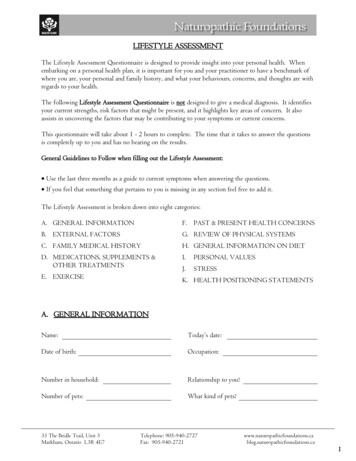
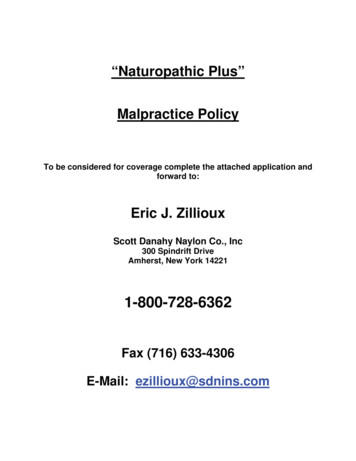
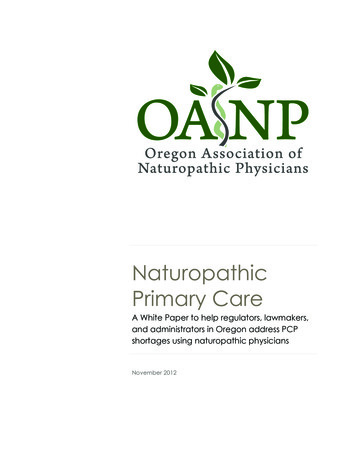
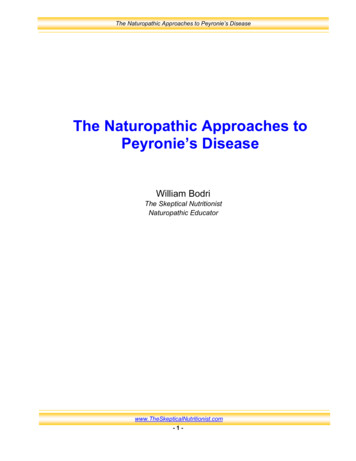
![[MS-ADFSOD]: Active Directory Federation Services (AD FS .](/img/1/5bms-adfsod-5d.jpg)
